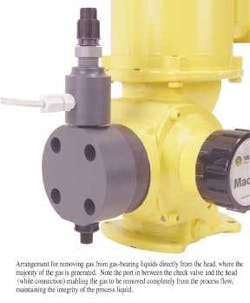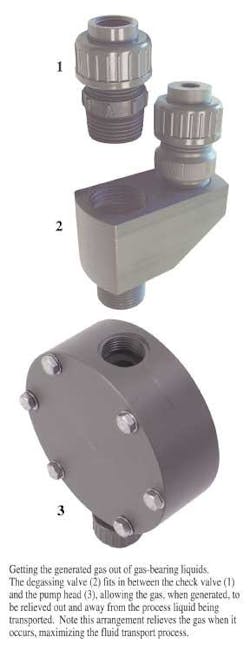Get The Gas Out: Degassing Solutions In Disinfection Systems
By Thomas J. Day
Gaseous chlorine was the mainstay solution for many years where disinfection of large facilities or water supplies was required. The move to replace gaseous chlorine systems with newer concepts and products has caused a variety of problems to arise in the installation, startup and operations of liquid disinfection fluid handling systems.
Most solutions for resolving these issues are relatively simple and straightforward. The intent here is to convey a working knowledge of the major liquid disinfection compounds, and explain the usual and ordinary solutions for degassing the fluid conveyance system.
Many chemicals have been introduced to replace chlorine as a disinfection agent. Of them, sodium hypochlorite and hydrogen peroxide are popular alternatives. Each of these chemicals has advantages and disadvantages, each with their own level of risk involved in storage and application. However, neither posses the risk that gaseous chlorine presents. Also, less chemical is required in general to obtain the same disinfection results.
They do have a common problem that makes application and dispersion difficult. Both are gas-bearing liquids and the release of that gas can pose issues when it comes to storage, pumping and application.
Storage
The release of gas in these chemicals causes the concentration of their liquid state to be reduced. Therefore, the first consideration is to have the chemical storage tanks in sheltered, fairly constant temperature environments out of direct sunlight. This includes all conveyance piping and accessories used in the application process. Also, the storage structures should be clear of agitating machinery that may cause direct or indirect vibration to the storage vessel. Resolving these issues in storage will assist in correcting any issues as related to pumping and dispersion downstream of the pump.
The application of light or the exposure of light to the containment vessel or accessory piping will raise the temperature, thereby risk the accelerated release of gas from the liquid. Storage containment should be sheltered observing the movement of the sun across the sky. The potential exposure of the containment building and piping to the sun's effects in conjunction with ambient temperatures at the given time of observation can provide excellent data in reducing these undesirable effects.
Significantly reducing or even eliminating gas formation in the tankage and conveyance system should be considered before looking inward to the pump.
Pumping
Once all of the subsequent external surrounding variables are considered, the pump is next to be observed for corrections and fine-tuning. Gas-bearing liquids in disinfection already have a high rate of evaporation potential. Rapid changes in vapor pressure will release more gas, causing additional problems in fluid delivery. Pumps used in disinfection chemical delivery are manufactured to pump liquid, not gas. Gas will bind and starve the pump, causing damage and inaccurate metering of the disinfection agent. Most of this damage is a result of cavitation.
Cavitation is the condition where a liquid transitions to a gas at a high rate, causing an energy release. This sounds similar to little 'pops' in a metering pump head. These are, in fact, little explosions that tend to eat away the inside of the pump head. The popping sound is the energy release. This condition generally occurs at startup where most of the internal damage occurs.
Continued pumping with gas being released in the pump head as a result of the agitation action of the diaphragm will cause inaccuracies in product dosing as gas will replace the liquid. Gas is compressible and therefore interferes with the general incompressible state of a liquid. If one considers that the displacement of the metering pump is accurate and consistent, the introduction of compressible gas will have devastating effects on both accuracy and delivery.
This poses the question of removing gas from the pump. Considering that the removal of generated gas can be a major factor in chemical delivery, direct methods are needed in getting the gas out. Some simple guidelines can be observed to assist the removal of vapor before damage occurs, or dosing rates are affected.
Gas Removal
The best method of getting the gas out of the metering pump head, based on current technology, is to directly extract the gas. This sounds almost intuitive and simple, but this is the only actual method to reduce or potentially eliminate effects of cavitation and other undesirable resultants of generated gas.
In the past, bleed valves were introduced directly into the metering pump head. These valves were effective and provided the necessary relief from the gas. Newer environmental regulations and the better understanding of the corrosive nature of these disinfection products now prevent this direct bleed-off into an uncontained location. As a result, new methods have been introduced.
The most effective and reliable method is to introduce a relief valve between the pump check valve and the metering pump head. This introduces relief directly into the pump head, and maintains the integrity of the check valve seal. The resultant gas-bearing liquid can then be returned to the containment for re-use. This also protects the local environment and complies with all regulations for contained chemical dispersion.
Returning the subsequent blow-by back to the tank takes with it the generated gas from the action of the metering pump head. This removes any gas-bearing liquid from the process stream. Some designs show a recirculation of that blow-by back to the suction side of the metering pump. The gas is still out of the liquid. Therefore, all that was accomplished is recirculating the gas back to the head. There will be some recondensing of the gas back to liquid, but not enough to fully mitigate gas effects within the head.
Some designs also call for a 'double-pumping' of the chemical. Unless the gas is fully removed, the design indicates continued gas generation as a result of agitation. Further, the amount of additional hardware to double-pump the liquid will add considerable expense to the pump overall.
Consideration also must be given to the timing of gas release. Automatic-controlled or timed valves do not release the gas when it needs to be released. These devices release the gas in some sequence, and not when the gas is prevalent. Certainly, these devices do provide relief.
However, they do not take in consideration the generation of gas from external disturbances or other conditions not directly related to the pump. Therefore, the valve should be of a design that releases the gas when it is formed, and not through an external sequence or programmed timing. One needs to consider that there is virtually no accurate method of determining the amount of gas generation within the metering pump head at any given moment. Such is the reason against any timed or automated sequence of gas removal.
The gas relief also needs to be in the pump head, at its head. There are many designs that call for line degassing. There is some benefit of having line degassing for external conditions. However, most of the gas forms in the head of the pump as a result of pump action. This is where the relief should be for maximum effect. An additional calibration column or line relief valve are certainly good ideas for additional or residual protection, and this is encouraged for backup and support purposes.
Keep in mind that the gas generation needs to be first addressed at the pump head, and the in-line valves considered only as backup and relief as described.
Keep the Gas Out
These parameters give adequate guidelines for considering the formation and removal of gas in chemical disinfection systems now replacing gaseous chlorine around the world. Simple considerations will ensure proper gas removal from the system, and maintain a delivery system with integrity. Although there are system design considerations, these degassing parameters should be considered for any design to be implemented. Keeping the gas out is a critical design and operations consideration in these delivery systems to ensure their proper dosing for disinfection and protection of the populations they serve.
About the Author: Thomas J. Day is the Product Manager for Mechanical and Hydraulic Technology for Milton Roy USA. He holds and undergraduate degree in Management, BS and MS in Engineering and has over 18 years experience in the Environmental Products and Process industry. He has over 35 technical papers published documenting his work in this industry including a textbook on infrastructure management.


